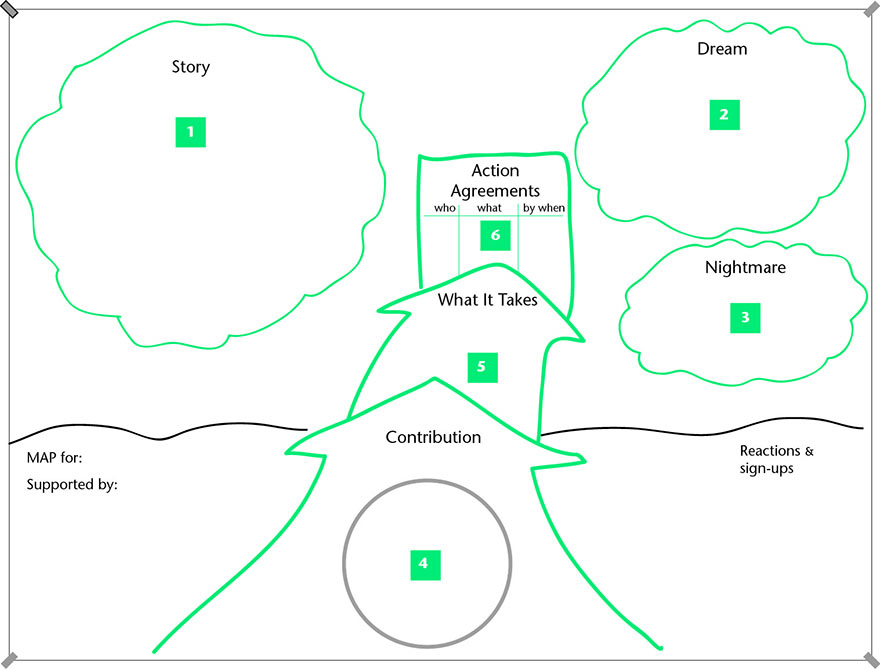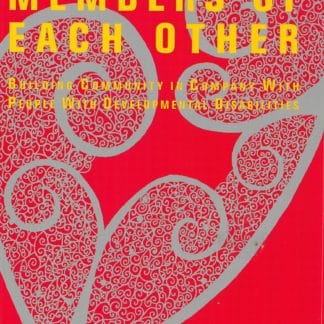ABSTRACT:
This sort article appeared in our book “Inclusion Papers” outlining the steps of a MAP as we understood them at that time (2001). We have evolved based our experience – and although this makes good reading (historically), we would recommend using the more current version of MAPS in the book...The PATH & MAPS Handbook
Marsha Forest – Books, Articles and Videos
Jack Pearpoint – Books, Articles and Videos
-
 PATH Classic$25.00
PATH Classic$25.00 -
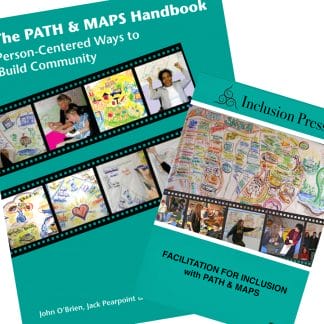 Facilitation for Inclusion with Path & Maps – Bundle$100.00
Facilitation for Inclusion with Path & Maps – Bundle$100.00 -
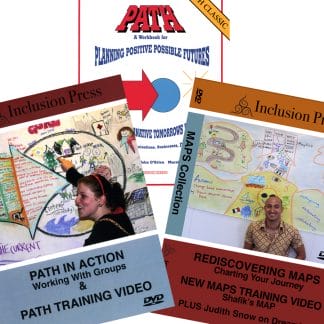 PATH in ACTION CLASSICAL BUNDLE$110.00
PATH in ACTION CLASSICAL BUNDLE$110.00 -
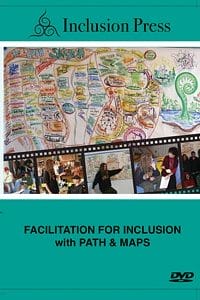 FACILITATION FOR INCLUSION with PATH & MAPS digital version of the DVD$85.00
FACILITATION FOR INCLUSION with PATH & MAPS digital version of the DVD$85.00 -
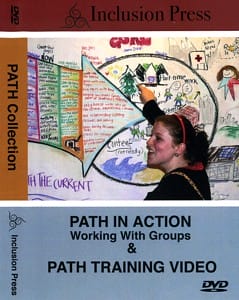 THE PATH Training DVD$75.00
THE PATH Training DVD$75.00 -
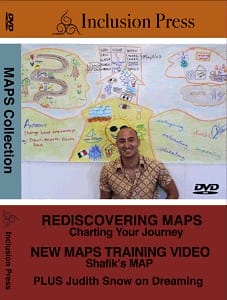 THE MAPS Videos: Rediscovering MAPS – the Digital download of the DVD$75.00
THE MAPS Videos: Rediscovering MAPS – the Digital download of the DVD$75.00 -
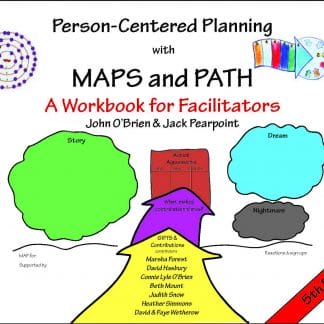 Person-Centered Planning with MAPS and PATH – A Workbook for Facilitators$25.00
Person-Centered Planning with MAPS and PATH – A Workbook for Facilitators$25.00 -
 PATHFINDERS$30.00
PATHFINDERS$30.00 -
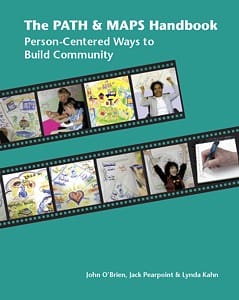 The PATH & MAPS Handbook: Person-Centered Ways to Build Community$35.00
The PATH & MAPS Handbook: Person-Centered Ways to Build Community$35.00
MAPS: Action Planning
to welcome people of all ages
into full life at home, school, work and play.
Marsha Forest & Jack Pearpoint
“What’s a Map?”
It is always the first question. It was so common, we incorporated it as the very first question in a series of “8 KEY MAPS QUESTIONS”.
In workshops to implement the MAPS process, we begin by asking the participants: “WHAT IS A MAP?” A recent group answered as follows:
– Something that gives direction
– A thing that helps you get somewhere
– Routes to different places
– Opens new ways to get anywhere
– To help you find your place
– A way to find a new way
– Stops you from getting lost
A Short History:
MAPS were originally designed by a team of educators who were searching for ways to help welcome children with disabilities back into regular schools and classrooms.
The concept of MAPS has now expanded. We see MAPS as a tool to help both organizations and individuals who are at risk of being isolated, institutionalized, left out, kicked out or locked out of the mainstream of life. This includes populations of people such as our older citizens, people with behavioral challenges, people in trouble with the law, people on the streets, people with mental health problems, and organizations who help these varied populations.
A MAP IS NOT and A MAP IS…
It is important at the outset to state clearly what a MAP is and what a MAP is NOT:
1. A MAP is NOT a trick, gimmick, quick fix, or a microwave solution to complex human problems. It is NOT a one shot session that will provide the magic bullet to blast a vulnerable person into the life of the community.
A MAP is a problem-solving approach to the complex human issues of life. It can and must be done as often as needed. At its core, it is PERSONAL, COMMON SENSE and FROM THE HEART. A MAP must ask over and over again – DOES WHAT WE ARE DOING MAKE SENSE FOR THIS PERSON OR ORGANIZATION?
2. A MAP is not a replacement for an Individual Education Plan (IEP). A MAP session may help provide information for an IEP or some other needed legal documentation, but it is not a substitute and must not be treated as such. In a MAP, the people giving input are personally and/or professionally involved in the person’s life. MAPS participants and contributors must be people who know the person or organization intimately, not simply people who have tested or given intermittent therapy to a person.
3. A MAP is not controlled by experts in order to design a neat program package.
The outcome of a MAP must be a PERSONALIZED PLAN OF ACTION that has three criteria:
a. The plan is personalized i.e. tailor made for the person or organization. It is a one-of-a-kind MAP.
b. The person is at the heart of the MAP.
c. The plan assists in bringing the person or organization closer and closer into the daily life of the school or community.
4. A MAP is not a tool to make any segregated setting better. MAPSwas designed to liberate people from institutional care. It is only for people and organizations trying to figure out together how to get a person fully included in life.
5. A MAP is not an academic exercise. It is a genuine personal approach to problem- solving. A MAP is for people who are vulnerable and outcome decisions have life and death implications for how the person will live his or her life. It is not a professional controlled/expert model/top-down management tool. It is a group, problem solving, cooperative and collaborative team approach to planning.
6. A MAP is not a Neutral Tool. The MAP facilitator must be skilled in group process, have leadership ability, have a problem-solving orientation, and most of all, have values that are clearly in favour of fully inclusive education and living. MAPS makes the value-judgment that it is better for all of us to figure out how to live together than to put people in little (or big) segregated boxes. MAPS facilitators must have a clear vision and share beliefs favouring the road of inclusion in all aspects of life.
7. MAPS is not talk. It is talk and Action. A MAP gives clear direction and takes action steps to move in the direction of inclusion. Most of all, MAPS is ongoing. It is a life long process of figuring out how to prevent the nightmare of segregation and how to enter into relationships that will lead to physical, mental and spiritual well-being.
8. The metaphor for the MAP is a KALEIDOSCOPE. The KALEIDOSCOPE is a magical toy, a mysterious and beautiful tool that changes constantly. Through the eyepiece we see little bits of color turning together into an ever-changing luminous melody of color and light.
We see the KALEIDOSCOPE as the outcome of each MAP. It is a medley of people working together to make something unique and better happen. It is more than they can do alone.
A MAP is a tool for creating a struggling community where all feel empowered to belong, to be needed, to be in control of their own lives. Most of all, people should feel loved for exactly who and what they are.
The Assumptions of the MAP Process:
1. All people are valuable and can contribute to life on this globe.
2. All people have abilities, talents and gifts.
3. All people can learn!
4. Disability is a social construct. People are not disabled. Systems disable people.
5. There is no need for special education or special educators. There is a real need for support, services, and educators who will reach out and nurture the potential of every child.
6. The only label we recommend is a person’s name. Labels hide the fact that we really don’t know what to do. After that, we suggest adopting a problem-solving mode that creatively figures out what to do for each unique individual.
7. Common sense is most Important and least common sense.
What We are Not Saying:
1. We are not saying that money isn’t necessary. We want all the money currently spent on testing, bussing and special education to be spent on inclusion: i.e. teacher assistants, child support workers, technical assistance, appropriate technology, etc. Money is definitely needed to provide the necessary support. However, “accessibility” is also a state of mind – and budgets must not be used as excuses not to include people.
2. We are not saying that anyone should be “dumped” without support and sit all day, unsupported in a regular class. We are saying that a team can figure out alternatives to segregated settings and find new, unique and better alternatives.
3. We are not saying that special educators are bad. We are saying that they have a major role to play in shifting the paradigm into “giftedness” rather than “disability”. Not only is there greater job security, it is a more rewarding and exciting educational environment to live and work in.
We see all people as “gifted.”
We believe all people are special unique and different. Because of this, some people fall through the cracks, get missed by the system or scare us half to death. We need to admit that we have missed a lot of people. We need to welcome everyone back into the mud, blood, gore and glory of life. Together, we need to figure out how to right past wrongs.
MAPS is just one small way that helps people come together to solve complex problems. MAPS is only necessary when you bump into a problem that seems difficult. It is one of many tools. Try it, use it, and write to us about your experiences. We find MAP MAKERS a pretty exciting bunch of people who like the personal and common sense team approach to creating a lifelong, caring and common sense curricula.
Who Goes to a MAP? – Friends!
The size of the group that gathers for a MAP session can vary from 2 to two dozen. The key ingredients for participants are Intimate and Personal Contact with the individual being mapped. A grandmother or neighbor, a friend – all are on equal footing with doctors, lawyers and teachers. Parents and family usually have the most to offer – if asked. Their perspectives are all welcome in a MAP. Professionals are welcome too – but as individuals – not as “therapists”.
As groups grow, the age spectrum tends to become more comprehensive. For example, for a MAP on a 10 year old, there would be several peers, perhaps some teenagers, parents, relatives, and some individuals with “elder” status.
Peer participation is critical. In a school situation, class/age/mates have enormous untapped energy and creative capacity. They often empower the teachers with new ideas, person power and just “straight talk”. The usual constraint is from us – adults. We often restrain or downgrade the participation of peers. They are critical and equal partners in the process.
There is a delicate question about whether the individual being “mapped” should be present. It is a judgment call. It works both ways. We hedge toward full participation. People understand an enormous amount – more than we think. A MAP is an upper for people who have been excluded. Why not give them a boost. It also saves time in trying to explain it all later.
MAPS Facilitation:
“Mapping” is a collaborative process. It is virtually impossible to “do it alone”. One individual focuses on the questions – facilitating the group. The other is the Recorder. They may interchange from time to time. The role of the facilitator is relatively straight forward – even though it requires practice, intuition and skill. Making it look easy comes from years of practice.
Public recording is also a critical part of the process. There are several reasons for the graphic recording.
1. Public recording acknowledges everyone’s participation – each person gets his or her mark on the paper.
2. It creates “images” that speed up the process. People are able to visualize the elements in the questions – and see both their dreams and their nightmares.
3. It creates a history. The records from each MAP are kept and are often used to recall the past. Remarkably, many people cannot believe the changes in their own perceptions and reality until they see the actual records of an earlier MAP.
4. It maintains interest – and assists recall. It helps to keep it moving.
5. It makes people feel good. They feel special. All this for “me”. All these people. All this – and all these wonderful words – that are recorded for posterity (and for ACTION planning).
The “recorder” need not be an artist. That is not the point. However, it is vital that the individual print/write clearly – and use “people’s own words” and images. You can supplement – but be sure everyone is included.
The Recorder and Facilitator are a TEAM. They must work well together. Alternating roles can keep the MAP process moving. But as usual, a solid value base and “practice” are the secrets of the trade. If you are committed to the process, try it. The way to learn is to do it.
MAPS: EIGHT KEY QUESTIONS
1. What is a MAP? Ask the participants.
2. What is the Story/History of the person, family? Ask those most intimate with the person to relate the highlights (and low points) of the individual’s history (short – 10-15 minutes).
3. What Is the dream? What do you really hope for, pray for, wish for? Do not be limited by money or reality. What would you dare to dream if you could have anything you wanted? Remind people not to ask for what they don’t want. They just might get it.
4. What is the nightmare? What is your greatest fear? For us, this question is the hardest to ask and the most important to get on the table. We must understand the nightmare in order to prevent it. Preventing the nightmare is the measure of success. The MAPS outcome must reflect an understanding of the nightmare. All actions are targeted to prevent the nightmare from happening. For families of children with disabilities, the nightmares are consistent:
“My n4htmare is that I will die and no one will be there to love and care for my child.”
“My child will end up in an institution – alone and without friends.”
“My child will die without ever knowing real life and experiencing friends.” No parent has ever said: “M nightmare is that my child won’t attend university, won’t get an A on the next test, or won’t learn how to spell.”
5. Who is the Person? This question shifts the MAP into a brainstorm mode. Everyone present is asked to give words or phrases that describe the person in question. Here’s an example from a recent MAP: “Who is Margot?”
· 15 years old
· Lots of fun
· Active like crazy
· Radical
· Very radical
· Bad (really means good)
To some, Margot is a -severely handicapped, autistic, mentally retarded teenager.” To the members of the MAPS group (three of whom were teenagers), Margot was mostly “BAD!” (which they translated to us as meaning good).
6. What are Margot’s strengths, abilities, gifts, talents? What does she do well? What does she like to do? This is also a brainstorm. It should not take long. Generate a list.
7. What are Margot’s real current NEEDS? Much like the strengths, this is a brainstorm. Don’t let people stop each other. Just record people’s words and perceptions. Keep it short. Don’t get bogged down.
In this MAP, there was uniform agreement that what Margot needed most of all was:
· FRIENDS
· PLACES TO GO
· TO BE IN A REAL, REGULAR HIGH SCHOOL.
8. What is the Plan of ACTION for Margot and for the MAPS team? All ideas were listed to start the process of getting Margot into her local High School.
A MAP is a catalyst to begin a process of change. A date was set for the next MAP. A commitment was made on the part of several key professionals and two energetic and “bad/cool” teenagers to meet as a smaller group. The MAP is on the drawing board. Over the next months & years, it will take on more detail and undergo constant revision. MAPS is a process. It is not a one shot cure. But it certainly is a beginning to plan and implement a better life.
For Information on MAPS process, write
Inclusion Press International
47 Indian Trail,
Toronto, Ontario,
Canada M6R 1Z8.
Visit our Web site: https://inclusion.com
Resources:
Books:
ACTION FOR INCLUSION Strategies for making Inclusion happen by O’Brien
Refections on Inclusive Education: Short reflections by the late Patrick Mackan C.R.- perfect for schools, churches. Profound words from the heart of Father Pat.
FROM BEHIND THE PIANO, the Building of Judith Snow’s Unique Circle of Friends by Jack Pearpoint. A story of courage, defeat and victory – more fascinating than fiction.
and
What’s Really Worth Doing, by Judith Snow – combined in one book.
CIRCLE OF FRIENDS by Bob and Martha Perske is a book of the stories (and faces of inclusion. It is a must and can be ordered through Abingdon Press in Nashville or Welch Publishing Co. in Burlington Ont. (416-681-2760)
Videos:
ReDiscovering MAPS: The most recent and comprehensive MAPS video. Demonstrations of two different MAPS and two sets of faciliators demonstrate a range of styles of facilitation – as well as leading you throught the steps of the MAPS process. How to make Inclusion happen involving a team of children, parents, neighbors and professionals in a creative team. Sixty minutes.
Available through Inclusion Press. ($100 plus shipping and handling).
Miller’s MAP: A 40 minute video. How to make Inclusion happen involving a team of children, parents, neighbors and professionals in a creative team. Co-facilitation. Colorful graphics.
Available through Inclusion Press.
With A Little Help From My Friends: A 60 minute video featuring students involved in the MAPS process.
Kids Belong Together: A 24 minute video – the story of teachers and children living and learning together. MAPS In action featuring Patrick Mackan.
Available through Inclusion Press.Copyright 2001 Inclusion Press — All rights reservedThis article is copied from INCLUSION PAPERS, Strategies to Make Inclusion Work
pages 52-56 published by Inclusion Press
www.inclusion.com
